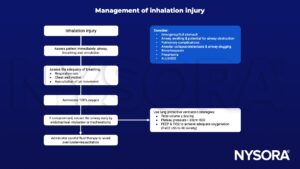Learning objectives
- Definition, classification, and management of inhalation injury
Definition and mechanisms
- Refers to damage to the respiratory tract or lung tissue from heat, smoke, or chemical irritants carried into the airway during inspiration
- The term is often used synonymously with smoke inhalation injury
Classification and causes
| Cause | Effect | |
|---|---|---|
| Upper airway injury | Hot air Steam | Laryngeal obstruction Bronchospasm |
| Tracheobronchial injury | Chemicals in smoke Inhalation of noxious gases (eg, chlorine) or liquids (eg, acid) Direct airway fire (eg, intraoperative) Aspiration | Mucosal slough Infection Bronchiolar plugging Atelectasis href="https://www.nysora.com/anesthesia/bronchospasm/">Bronchospasm |
| Parenchymal injury | Irritant gases | Pneumonia Pulmonary edema Alveolar capillary defect |
| Systemic toxicity | CO poisoning Hydrogen cyanide |
Signs and symptoms
- Voice changes
- Hoarseness
- Stridor
- Cough
- Respiratory distress
- Decreased level of consciousness or confusion
- Agitation
- Clinical hypoxemia (SpO2 <94%)
- Dizziness
- Nausea
- Vomiting
Management

Keep in mind
General burn considerations:
- Hypovolemic shock
- Hypo or hyperthermia
- Rhabdomyolysis
- Cardiac depression
- DIC, consumptive coagulopathy
Suggested reading
- Preea Gill, FRCA, Rebecca V Martin, FRCA FFICM, Smoke inhalation injury, BJA Education, Volume 15, Issue 3, June 2015, Pages 143–148.
- Bittner EA, Shank E, Woodson L, Martyn JA. Acute and perioperative care of the burn-injured patient. Anesthesiology. 2015;122(2):448-464.
We would love to hear from you. If you should detect any errors, email us customerservice@nysora.com


